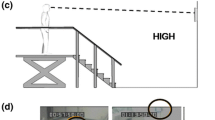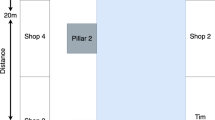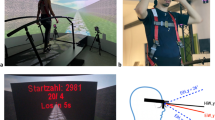Abstract
We investigated gaze behaviour and collision avoidance strategies in 16 healthy young individuals walking towards a goal while exposed to virtual pedestrians (VRPs) approaching from different directions (left, middle, right). This locomotor task and an auditory-based cognitive task were performed under single and dual-task conditions. Longer gaze fixation durations were observed on the approaching vs. other VRPs, with longer fixations devoted to the upper trunk and head compared to other body segments. Compared to other pedestrian approaches, the middle pedestrian received longer fixations and elicited faster walking speeds, larger onset distances of trajectory devitation and smaller obstacle clearances. Gaze and locomotor behaviours were similar between single and dual-task conditions but dual-task costs were observed for the cognitive task. The longer gaze fixations on approaching vs. other pedestrians suggest that enhanced visual attention is devoted to pedestrians posing a greater risk of collision. Likewise, longer gaze fixations for the middle pedestrians may be due to the greater collision risk entailed by this condition, and/or to the fact that this pedestrian was positioned in front of the end goal. Longer fixations on approaching VRPs’ trunk and head may serve the purpose of anticipating their walking trajectory. Finally, the dual-task effects that were limited to the cognitive task suggest that healthy young adults prioritize the locomotor task and associated acquisition of visual information. The healthy patterns of visuomotor behaviour characterized in this study will serve as a basis for comparison to further understand defective collision avoidance strategies in patient populations.




Similar content being viewed by others
Data availability
Data presented in the context of this study cannot be made available, as this option was not included in the consent forms signed by participants. As per these consent forms, the data are to be destroyed by the research team 5 years after the end of the project.
References
Aravind G, Lamontagne A (2017) Dual tasking negatively impacts obstacle avoidance abilities in post-stroke individuals with visuospatial neglect: task complexity matters! Restor Neurol Neurosci 35(4):423–436. https://doi.org/10.3233/RNN-160709
Berton F, Hoyet L, Olivier AH, Bruneau J, Le Meur O, Pettré J (2020) Eye-gaze activity in crowds: impact of virtual reality and density. In: VR 2020—27th IEEE conference on virtual reality and 3D user interfaces (Mars 2020), pp 1–10
Berton F, Olivier AH, Bruneau J, Hoyet L, Pettre J (2019) Studying gaze behaviour during collision avoidance with a virtual walker: influence of the virtual reality setup. In: 2019 IEEE conference on virtual reality and 3D user interfaces (VR), Osaka, Japan
Bhushan B, Khan SM (2006) Laterality and accident proneness: a study of locomotive drivers. Laterality Asymm Body Brain Cogn 11(5):395–404. https://doi.org/10.1080/13576500500457458
Bohannon RW, Williams Andrews A (2011) Normal walking speed: a descriptive meta-analysis. Physiotherapy 97(3):182–189. https://doi.org/10.1016/j.physio.2010.12.004
Boulanger M, Lamontagne A (2017) Eye-head coordination during overground locomotion and avoidance of virtual pedestrians. In: 2017 international conference on virtual rehabilitation (ICVR), Montreal
Buhler MA, Lamontagne A (2018) Circumvention of pedestrians while walking in virtual and physical environments. IEEE Trans Neural Syst Rehabil Eng 26(9):1813–1822. https://doi.org/10.1109/tnsre.2018.2865907
Buhler MA, Lamontagne A (2022) Coordinating clearance and postural reorientation when avoiding physical and virtual pedestrians. IEEE Trans Neural Syst Rehabil Eng 30:1612–1620. https://doi.org/10.1109/tnsre.2022.3181817
Chan CS, Slaughter SE, Jones CA, Wagg AS (2015) Greater independence in activities of daily living is associated with higher health-related quality of life scores in nursing home residents with dementia. Healthcare (basel, Switzerland) 3(3):503–518. https://doi.org/10.3390/healthcare3030503
Cinelli M, Patla A, Stuart B (2008) Age-related differences during a gaze reorientation task while standing or walking on a treadmill. Exp Brain Res 185(1):157–164. https://doi.org/10.1007/s00221-007-1266-8
Croft JL, Panchuk D (2018) Watch where you’re going? Interferer velocity and visual behavior predicts avoidance strategy during pedestrian encounters. J Motor Behav 50(4):353–363. https://doi.org/10.1080/00222895.2017.1363695
Darekar A, Lamontagne A, Fung J (2017) Locomotor circumvention strategies are altered by stroke: I. Obstacle clearance. J NeuroEng Rehab. https://doi.org/10.1186/s12984-017-0264-8
Deblock-Bellamy A, Lamontagne A, Blanchette AK (2020) Cognitive-locomotor dual-task interference in stroke survivors and the influence of the tasks: a systematic review. Front Neurol 11:882. https://doi.org/10.3389/fneur.2020.00882
Deblock-Bellamy A, Lamontagne A, McFadyen BJ, Ouellet MC, Blanchette AK (2021) Virtual reality-based assessment of cognitive-locomotor interference in healthy young adults. J Neuroeng Rehabil 18(1):53. https://doi.org/10.1186/s12984-021-00834-2
Ellmers TJ, Cocks AJ, Doumas M, Williams AM, Young WR (2016) Gazing into thin air: the dual-task costs of movement planning and execution during adaptive gait. PLoS ONE 11(11):e0166063. https://doi.org/10.1371/journal.pone.0166063
Feld JA, Plummer P (2019) Visual scanning behavior during distracted walking in healthy young adults. Gait Posture 67:219–223. https://doi.org/10.1016/j.gaitpost.2018.10.017
Gerin-Lajoie M, Richards CL, McFadyen BJ (2005) The negotiation of stationary and moving obstructions during walking: anticipatory locomotor adaptations and preservation of personal space. Mot Control 9(3):242–269
Geruschat DR, Hassan S, Turano KA (2003) Gaze behavior while crossing complex intersections. Optometry vis Sci 80(7):515–528
Grasso R, Prévost P, Ivanenko YP, Berthoz A (1998) Eye-head coordination for the steering of locomotion in humans: an anticipatory synergy. Neurosci Lett 253(2):115–118. https://doi.org/10.1016/S0304-3940(98)00625-9
Grubb JD, Reed CL, Bate S, Garza J, Roberts RJ (2008) Walking reveals trunk orientation bias for visual attention. Percept Psychophys 70(4):688–696. https://doi.org/10.3758/PP.70.4.688
Hollands MA, Patla AE, Vickers JN (2002) “Look where you’re going!”: gaze behaviour associated with maintaining and changing the direction of locomotion. Exp Brain Res 143(4):221–230
Huber M, Su Y-H, Krüger M, Faschian K, Glasauer S, Hermsdörfer J, Lappe M (2014) Adjustments of speed and path when avoiding collisions with another pedestrian. PLoS ONE 9(2):e89589. https://doi.org/10.1371/journal.pone.0089589
Imai T, Moore ST, Raphan T, Cohen B (2001) Interaction of the body, head, and eyes during walking and turning. Exp Brain Res 136(1):1–18. https://doi.org/10.1007/s002210000533
Joshi HB, Cybis W, Kehayia E, Archambault PS, Lamontagne A (2021) Gaze behavior during pedestrian interactions in a community environment: a real-world perspective. Exp Brain Res 239(7):2317–2330. https://doi.org/10.1007/s00221-021-06145-1
Jovancevic-Misic J, Hayhoe M (2009) Adaptive gaze control in natural environments. J Neurosci 29(19):6234–6238. https://doi.org/10.1523/JNEUROSCI.5570-08.2009
Kaiser PK (2009) Prospective evaluation of visual acuity assessment: a comparison of snellen versus ETDRS charts in clinical practice (An AOS Thesis). Trans Am Ophthalmol Soc 107:311–324
Kelly VE, Eusterbrock AJ, Shumway-Cook A (2013) Factors influencing dynamic prioritization during dual-task walking in healthy young adults. Gait Posture 37(1):131–4. Epub 2012 Aug 30. https://doi.org/10.1016/j.gaitpost.2012.05.031
Kitazawa K, Fujiyama T (2010) Pedestrian vision and collision avoidance behavior: investigation of the information process space of pedestrians using an eye tracker. In: Klingsch WWF et al (eds) Pedestrian and evacuation dynamics 2008. Springer, Berlin, Heidelberg
Kovacs C (2005) Age-related changes in gait and obstacle avoidance capabilities in older adults: a review. J Appl Gerontol 24(1):21–34
Lamontagne A, Fung J (2009) Gaze and postural reorientation in the control of locomotor steering after stroke. Neurorehabil Neural Repair 23(3):256–266. https://doi.org/10.1177/1545968308324549
Lynch SD, Kulpa R, Meerhoff LA, Pettre J, Cretual A, Olivier AH (2018a) Collision avoidance behavior between walkers: global and local motion cues. IEEE Trans vis Comput Graph 24(7):2078–2088. https://doi.org/10.1109/tvcg.2017.2718514
Lynch SD, Pettré J, Bruneau J, Kulpa R, Crétual A, Olivier A (2018b) Effect of virtual human gaze behaviour during an orthogonal collision avoidance walking task. In: 2018b IEEE conference on virtual reality and 3D user interfaces (VR), pp 136–142. https://doi.org/10.1109/VR.2018.8446180
Marigold DS, Patla AE (2007) Gaze fixation patterns for negotiating complex ground terrain. Neuroscience 144(1):302–313. https://doi.org/10.1016/j.neuroscience.2006.09.006
Meerhoff LA, Bruneau J, Vu A, Olivier AH, Pettre J (2018) Guided by gaze: prioritization strategy when navigating through a virtual crowd can be assessed through gaze activity. Acta Psychol (Amst) 190:248–257. https://doi.org/10.1016/j.actpsy.2018.07.009
Miyasike-daSilva V, McIlroy WE (2012) Does it really matter where you look when walking on stairs? Insights from a dual-task study. PLoS ONE 7(9):e44722. https://doi.org/10.1371/journal.pone.0044722
Nummenmaa L, Hyönä J, Hietanen JK (2009) I’ll walk this way: eyes reveal the direction of locomotion and make passersby look and go the other way. Psychol Sci 20(12):1454–1458
Patla AE (1997) Understanding the roles of vision in the control of human locomotion. Gait Posture 5(1):54–69. https://doi.org/10.1016/s0966-6362(96)01109-5
Patla AE, Vickers JN (1997) Where and when do we look as we approach and step over an obstacle in the travel path? NeuroReport 8(17):3661
Patla AE, Vickers JN (2003) How far ahead do we look when required to step on specific locations in the travel path during locomotion? Exp Brain Res 148(1):133–138. https://doi.org/10.1007/s00221-002-1246-y
Patla AE, Adkin A, Martin C, Holden R, Prentice S (1996) Characteristics of voluntary visual sampling of the environment for safe locomotion over different terrains. Exp Brain Res 112(3):513–522. https://doi.org/10.1007/BF00227957
Patla AE, Shumway-Cook A (1999) Dimensions of mobility: defining the complexity and difficulty associated with community mobility. J Aging Phys Activity 7(1):7–19
Plummer P, Eskes G, Wallace S, Giuffrida C, Fraas M, Campbell G, Clifton KL, Skidmore ER, American Congress of Rehabilitation Medicine Stroke Networking Group Cognition Task, F (2013) Cognitive-motor interference during functional mobility after stroke: state of the science and implications for future research. Arch Phys Med Rehab 94(12):2565–2574. https://doi.org/10.1016/j.apmr.2013.08.002
Plummer-D’Amato P, Altmann LJP, Saracino D, Fox E, Behrman AL, Marsiske M (2008) Interactions between cognitive tasks and gait after stroke: a dual task study. Gait Posture 27(4):683–688. https://doi.org/10.1016/j.gaitpost.2007.09.001
Reio T, Czarnolewski M, Eliot J (2004) Handedness and spatial ability: differential patterns of relationships. Laterality Asymm Body Brain Cogn 9(3):339–358
Shumway-Cook A, Patla AE, Stewart A, Ferrucci L, Ciol MA, Guralnik JM (2002) Environmental demands associated with community mobility in older adults with and without mobility disabilities. Phys Ther 82(7):670–681
Souza Silva W, Aravind G, Sangani S, Lamontagne A (2018) Healthy young adults implement distinctive avoidance strategies while walking and circumventing virtual human vs. non-human obstacles in a virtual environment. Gait Posture 61:294–300. https://doi.org/10.1016/j.gaitpost.2018.01.028
Souza Silva W, McFadyen B, Fung J, Lamontagne A (2019) Effects of age on obstacle avoidance while walking and deciphering text versus audio phone messages. Gerontology 65(5):524–536. https://doi.org/10.1159/000499067
Souza Silva W, McFadyen BJ, Fung J, Lamontagne A (2020) Reading text messages at different stages of pedestrian circumvention affects strategies for collision avoidance in young and older adults. Gait Posture 76:290–297. https://doi.org/10.1016/j.gaitpost.2019.11.017
Wilkie RM, Wann JP (2003) Eye-movements aid the control of locomotion. J vis 3(11):677–684. https://doi.org/10.1167/3.11.3
Wincenciak J, Willis A, Egan C (2010) Walking, talking and looking: effects of divided attention on gaze behaviour and visual search performance in a real-world environment. Perception. https://doi.org/10.1068/v100520
Wright RD, Ward LM (2008) Orienting of attention. Oxford University Press, Oxford
Yogev-Seligmann G, Hausdorff JM, Giladi N (2012) Do we always prioritize balance when walking? Towards an integrated model of task prioritization. Mov Disord 27(6):765–770. https://doi.org/10.1002/mds.24963
Acknowledgements
The authors would like to thank Christian Beaudoin and Samir Sangani for programming the experiment, as well as participants who took part in the study.
Funding
This study was funded by the National Sciences and Engineering Research Council of Canada (RGPIN-04471-2016). TMB was the recipient of scholarships from the McGill School of Occupational and Physical Therapy and the Centre for Interdisciplinary Research in Rehabilitation of Greater Montréal.
Author information
Authors and Affiliations
Corresponding author
Ethics declarations
Conflict of interest
The authors declare that they have no conflict of interest.
Additional information
Communicated by Bill J Yates.
Publisher's Note
Springer Nature remains neutral with regard to jurisdictional claims in published maps and institutional affiliations.
Rights and permissions
Springer Nature or its licensor holds exclusive rights to this article under a publishing agreement with the author(s) or other rightsholder(s); author self-archiving of the accepted manuscript version of this article is solely governed by the terms of such publishing agreement and applicable law.
About this article
Cite this article
Bhojwani, T.M., Lynch, S.D., Bühler, M.A. et al. Impact of dual tasking on gaze behaviour and locomotor strategies adopted while circumventing virtual pedestrians during a collision avoidance task. Exp Brain Res 240, 2633–2645 (2022). https://doi.org/10.1007/s00221-022-06427-2
Received:
Accepted:
Published:
Issue Date:
DOI: https://doi.org/10.1007/s00221-022-06427-2




